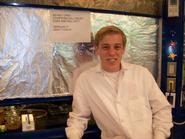
As a high school student, Keith Willner ’11 was very interested in chemistry but had no interest in going to Hamilton because he was a local student and felt it was too close to home. “My parents dragged me on a tour of campus.” But as soon as he entered the Science Center, with its towering glass windows and immaculate, well-equipped labs, his sullen attitude went away. “I was hooked,” he said. Now Willner is a budding chemist working for the Silas D. Childs Professor of Chemistry Robin Kinnel. The goal of his research this summer is to establish that the (-) enantiomer of germacrene D is the principal chemical signal for feeding and egg laying in the female Phyciodes tharos (Pearl Crescent) butterfly.
Many butterflies that belong to this species lay their eggs on aster leaves, and their larvae feed on the aster foliage. Kinnel and his colleagues have observed that there are concentrations of a certain molecule known as germacrene D on the aster.
These butterflies tend to lay their eggs on leaves that have a very high of (-) to (+) germacrene D. The positive and negative signs refer to the enantiomers of the molecule. In order to understand what an enantiomer is, it is necessary to take a few steps back.
Chemists often study compounds called isomers. If two compounds are isomers of each other, that means that they have the same molecular structure but a different structural formula. In simple terms, they may have the exact same number of carbon and hydrogen bonds, but one compound’s arrangement of these elements will be different from its isomer’s. An enantiomer is a kind of isomer that is a mirror image, much like hands are the same structurally but are reflections of each other.
Willner is looking to confirm his hypothesis that (-) enantiomer should elicit a much stronger electrical response in the antennae of the butterfly. Because they seem to have an obvious preference for aster with a greater amount of the (-) enantiomer, the butterflies should be more responsive to them.
However, (+) germacrene D is not readily available from natural sources like (-) germacrene D is. Thus, Willner is working on a synthesis for the (+) germacrene D, and will attempt to optimize the synthesize pathway - that is, he wants more moles for his money.
This project is a continuation on previous senior theses. Willner says he and his chemicals have spent some quality time together.
“It almost becomes personal,” he mused. He describes a reaction that has been a particular challenge: “When I make that go, there will be loud cheering coming from the Science Center.”
He does not limit this kind of commitment to just academics, though. Willner is an EMT, plays the saxophone, and has recently been elected to the position of Student Assembly president of the Class of 2011. After his exploits at Hamilton, he plans to attend medical school.
Many butterflies that belong to this species lay their eggs on aster leaves, and their larvae feed on the aster foliage. Kinnel and his colleagues have observed that there are concentrations of a certain molecule known as germacrene D on the aster.
These butterflies tend to lay their eggs on leaves that have a very high of (-) to (+) germacrene D. The positive and negative signs refer to the enantiomers of the molecule. In order to understand what an enantiomer is, it is necessary to take a few steps back.
Chemists often study compounds called isomers. If two compounds are isomers of each other, that means that they have the same molecular structure but a different structural formula. In simple terms, they may have the exact same number of carbon and hydrogen bonds, but one compound’s arrangement of these elements will be different from its isomer’s. An enantiomer is a kind of isomer that is a mirror image, much like hands are the same structurally but are reflections of each other.
Willner is looking to confirm his hypothesis that (-) enantiomer should elicit a much stronger electrical response in the antennae of the butterfly. Because they seem to have an obvious preference for aster with a greater amount of the (-) enantiomer, the butterflies should be more responsive to them.
However, (+) germacrene D is not readily available from natural sources like (-) germacrene D is. Thus, Willner is working on a synthesis for the (+) germacrene D, and will attempt to optimize the synthesize pathway - that is, he wants more moles for his money.
This project is a continuation on previous senior theses. Willner says he and his chemicals have spent some quality time together.
“It almost becomes personal,” he mused. He describes a reaction that has been a particular challenge: “When I make that go, there will be loud cheering coming from the Science Center.”
He does not limit this kind of commitment to just academics, though. Willner is an EMT, plays the saxophone, and has recently been elected to the position of Student Assembly president of the Class of 2011. After his exploits at Hamilton, he plans to attend medical school.
Posted August 6, 2009
